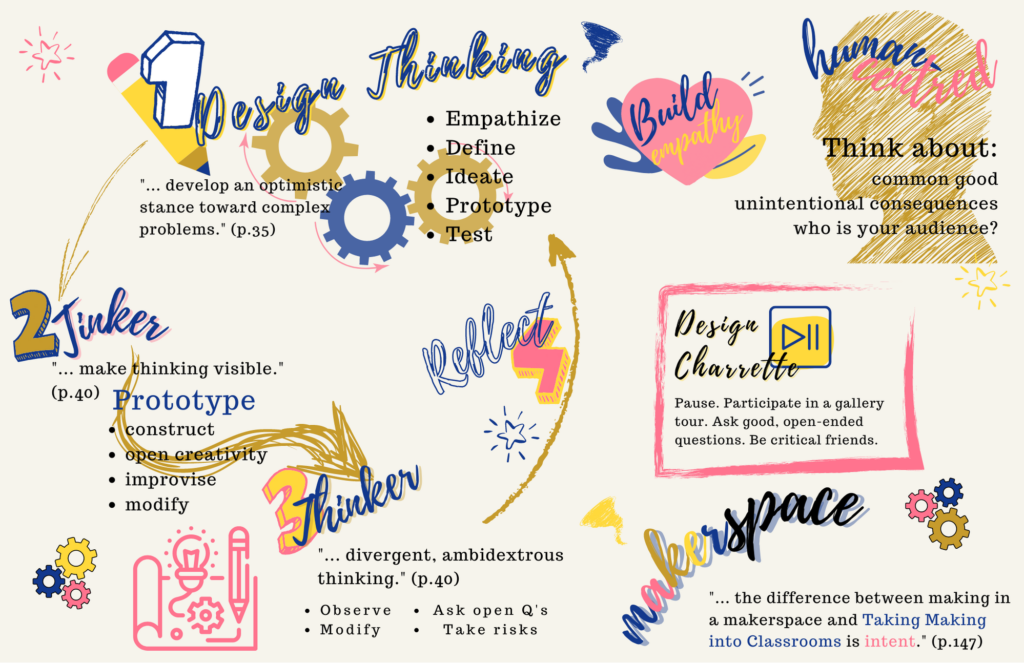Problem: Teachers have not grown out of the traditional view of the library as a place to retrieve books.

Reframe: Teachers with traditional views of the school library are underutilizing the space.
Developing relationships with teachers and administrators in order to reframe their existing understanding of the purpose of the library will help in the process of transforming school libraries into 21st century library learning commons (LLCs). Ample research supports that a LLC has direct correlations to improved student achievement and lifelong learning skills. (CSL, 2020)
Problem: Inflexible library scheduling prevents open access to resources like the Makerspace.
Currently, the library operates on a schedule, with classes rotating in as the TL covers prep times throughout the day. There are very few “open blocks” where students and teachers can informally use the space for pleasure reading, group work, teacher/TL collaboration, events, etc. The positioning of the Makerspace within the library also means that students and teachers are not able to access the materials whenever they need or want them.
Reframe 1: Inflexible scheduling prevents open access to library resources.
Changing the library scheduling from fixed to flexible (or “mixed”) has a proven positive effect on student achievement (Haycock, 2002), and may allow the library to become more accessible to the flexible and diverse needs of students, teachers, and classes. By integrating a flexible schedule, the library space can then be used as it is needed. It is important to develop strong relationships with classroom teachers, administrators, and students so that they know to use the library as a research tool, a collaborative space, and a safe zone for self-regulation (Needham, 2003).
Reframe 2: A fixed Makerspace is not always accessible, given library scheduling constraints.
There are certainly advantages to having a permanent Makerspace, especially when library scheduling is flexible and allows students access to the space whenever inspiration strikes. Creating a mobile Makerspace allows teachers to bring the cart to their own space, reduces some accessibility challenges, and can also be a solution in schools with limited library physical space and budget (Craddock, 2015) (YALSA, 2014).
Let’s Focus:
I am going to focus on designing a mobile makerspace, because I think this is a challenge that many schools face. My hope is that the solutions to this challenge can be implemented immediately so that schools can benefit from the skills and processes developed when engaged in the design thinking process.
Design Challenge
Design a mobile, or pop-up, Makerspace that fits your school library budget, facilitates students using the design thinking process, and can be easily carted from one classroom to another. Be sure to include a plan for tracking and replacing materials as they are used, as well as a booking schedule so that teachers can easily reserve the cart as needed.
References:
Craddock, I. L. (2015). Makers on the move: a mobile makerspace at a comprehensive public high school. Library Hi Tech, 33(4), 497–504. https://doi.org/10.1108/LHT-05-2015-0056
Canadian School Libraries (CSL). 2020. “Leading Learning: Standards of Practice for School Library Learning Commons in Canada.” Available: http://llsop.canadianschoollibraries.ca
Haycock, K. (2002). Flexible scheduling revisited. .(Brief Article). Teacher Librarian (Vancouver), 29(3), 6–.
Needham, J. (2003). From fixed to flexible: making the journey. Teacher Librarian (Vancouver), 30(5), 8–.
YALSA. (2014). Making in the Library Toolkit: Makerspace Resources Task Force (p. 8-9, 37).



Recent Comments